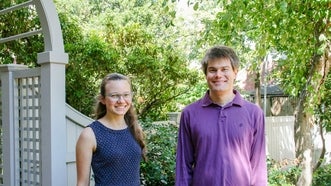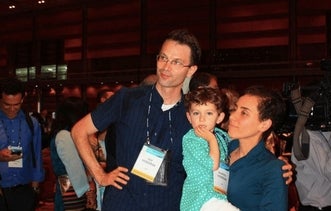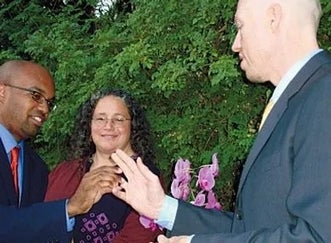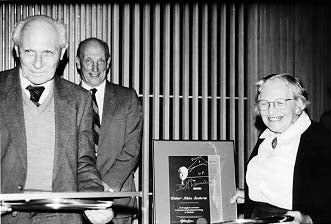Cardioid equations aside, people don’t often associate math and romance. This Valentine’s Day, we’re highlighting four couples whose meeting of hearts was also a meeting of the mathematical minds.
Isabel Vogt and Eric Larson
Isabel Vogt is a mathematician at Brown University who studies the geometry of algebraic curves. Her husband, Eric Larson, is also a professor at Brown and an algebraic geometer. Together, they solved “the interpolation problem,” which mathematicians have been investigating for centuries. Vogt and Larson met in 2011 as undergraduate students at Harvard University, where they had the same mentor, Joe Harris. The pair both attended graduate school at MIT together, and along the way they got married. In their personal and professional lives, they’ve been collaborating ever since: the chalkboards they have at home were essential to working through the interpolation problem.

Isabel Vogt and Eric Larson (courtesy of The Brown Daily Herald)

Jan Vondrák, Maryam Mirzakhani, and their daughter Anahita (courtesy of the Tehran Times)
Maryam Mirzakhani and Jan Vondrák
Maryam Mirzakhani was a pioneering Iranian mathematician who became the first woman to win the Fields Medal in 2014 for her work on dynamics and geometry. In 2004, while she was a PhD student at Harvard University, she met Jan Vondrák, a Czech applied mathematician and theoretical computer scientist. The two got married in 2008, and a year later they moved to California, where they both became professors at Stanford University. In 2011, the couple had a daughter, Anahita, who often referred to her mother’s mathematical drawings and doodles as her “paintings.” Tragically, Mirzakhani died of breast cancer at the age of 40, but she continues to inspire generations of female mathematicians.
Ron Buckmire and Dean Elzinga
Ron Buckmire is a Grenadian mathematician, LGBT activist, and professor at Occidental College. As a young man, he began competing in competitive chess; in 1997 he was named a senior master and ranked among the top 250 chess players in the US. While earning his B.S. in mathematics at Rensselaer Polytechnic Institute in the late 1980s, he began using the internet to do LGBT activism. In 1991, he created the Queer Resources Directory, an online reference with information for gender and sexual minorities. That year, he also met his future husband, Dean Elzinga. Elzinga was a Renaissance man himself: in addition to earning an M.S. in Mathematics from UCLA and working as a data scientist and software engineer for major tech companies like IBM, Elzinga was also a professional opera singer for 20 years! In 2018, Buckmire was honored by the Network of Minorities in Mathematical Science; his advice to young mathematicians was to “remember the Golden Rule (and the Golden Ratio!).”

Ron Buckmire and Dean Elzinga on their wedding day (courtesy of The Advocate)

George Szekeres and Esther (Klein) Szekeres (courtesy of the Australian Mathematical Society
Esther Klein and George Szekeres
Esther Klein and George Szekeres were both born to Jewish parents in Budapest, Hungary, near the beginning of the twentieth century. Klein initially studied physics, and Szekeres studied chemistry, but both became part of a group of Hungarian mathematicians who worked closely together throughout their lives – including the famous Paul Erdős, of Erdős Number fame. Klein and Szekeres fell in love and got married in 1937; they would go on to have two children together. With the outbreak of World War II, the family fled Nazi persecution and moved to Shanghai, China, then eventually to Australia. They spent the rest of their lives in Australia, collaborating mathematically and working to improve math education in both Australia and New Zealand. In 2005, after a long and productive life, the pair died within an hour of each other. Their greatest mathematical legacy?: the 1935 “happy ending problem,” which they solved together while falling in love.